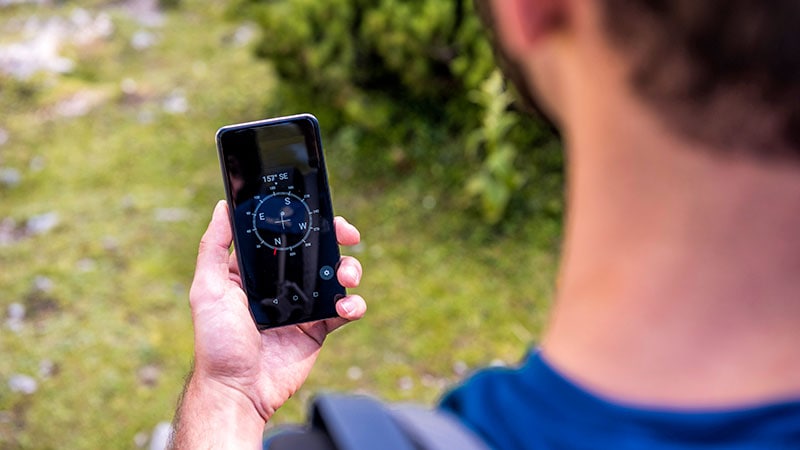Smartphone Compass Used to Measure Glucose and pH Levels in Liquids
Kernkonzepte
A smartphone's compass can be used to analyze biomarkers like glucose and pH in body fluids and other liquids through a simple, low-cost sensor strip.
Zusammenfassung
The content discusses a new method developed by researchers at the National Institute of Standards and Technology (NIST) that uses a smartphone's compass to measure biomarkers in liquids. The key highlights are:
- The researchers embedded a small magnet in a "smart hydrogel" strip that expands or contracts based on the concentration of the target biomarker, such as glucose or pH, in the liquid sample.
- As the hydrogel strip changes size, it moves the magnet, which the smartphone's magnetometer (compass) can detect. This allows the smartphone to measure the biomarker levels.
- In proof-of-concept tests, the researchers accurately measured glucose levels in alcoholic beverages and pH levels in various liquids using this method.
- The technique could potentially be adapted to detect other biomarkers or molecules, and could also be used to check for chemical contaminants in water.
- More testing is needed to confirm the method works with biological fluids like blood, sweat, or saliva. Challenges include potential interference from other molecules in complex fluids.
- The researchers aim to develop a simple, low-cost, and disposable sensor strip that can be used with a smartphone, similar to a pool pH test strip.
Zusammenfassung anpassen
Mit KI umschreiben
Zitate generieren
Quelle übersetzen
In eine andere Sprache
Mindmap erstellen
aus dem Quellinhalt
Quelle besuchen
www.medscape.com
A Fascinating Way to Measure Glucose With a Phone's Compass
Statistiken
The detection limit for glucose reached micromolar concentrations, on par with or better than some widely used glucose sensors.
Each pH hydrogel strip costs about 3 cents, and glucose strips cost 16 cents, with potential for lower prices in bulk.
Zitate
"We're just at this point demonstrating this new way of sensing that we hope [will be] very accessible and very portable."
"It might enable new capabilities for advanced sensing applications in field settings or even at home."
Wichtige Erkenntnisse aus
by Christina um www.medscape.com 04-17-2024
https://www.medscape.com/viewarticle/fascinating-way-measure-glucose-phones-compass-2024a10007ee
Tiefere Fragen
How could this smartphone-based biomarker detection method be further improved or optimized for use with complex biological fluids like blood or saliva?
To optimize this smartphone-based biomarker detection method for complex biological fluids like blood or saliva, several enhancements could be considered. Firstly, refining the specificity of the hydrogel strip's chemistry to target specific biomolecules in the fluid would be crucial. This would involve minimizing potential interference from other molecules present in the sample, ensuring accurate and reliable results. Additionally, conducting extensive testing with a variety of biological fluids to validate the method's effectiveness and reliability across different samples would be essential. Furthermore, incorporating advanced algorithms for data analysis and interpretation could enhance the accuracy and sensitivity of the measurements, especially in complex biological matrices. Collaborating with experts in biochemistry and biotechnology to fine-tune the hydrogel composition and detection mechanism could also lead to significant improvements in the method's performance with diverse biological fluids.
What are the potential limitations or drawbacks of relying on a smartphone's compass for biomarker analysis compared to other sensing technologies?
While utilizing a smartphone's compass for biomarker analysis presents innovative possibilities, there are several limitations and drawbacks to consider compared to other sensing technologies. One significant limitation is the potential interference from external magnetic fields, which could affect the accuracy and reliability of the measurements. The sensitivity of the smartphone's magnetometer may also be a limiting factor, as it may not be as precise or sensitive as dedicated laboratory equipment used in traditional biomarker analysis methods. Moreover, the need for calibration and coding to translate the readings into meaningful data could introduce complexities and potential errors in the analysis process. Additionally, the current method's reliance on a physical strip of hydrogel for detection may limit its scalability and adaptability for high-throughput or real-time monitoring applications, which are essential in clinical settings. Overall, while the smartphone-based approach is promising, addressing these limitations will be crucial to ensure its effectiveness and practicality for biomarker analysis.
How might this technology be leveraged to address broader public health challenges, such as remote monitoring or early disease detection?
The technology of using a smartphone's compass for biomarker analysis holds significant potential for addressing broader public health challenges, particularly in remote monitoring and early disease detection. By further developing and validating the method for detecting a wide range of biomarkers in biological fluids, it could enable individuals to perform self-assessments and monitor their health status remotely. This could be especially beneficial for individuals in underserved or remote areas with limited access to healthcare facilities. Additionally, integrating this technology with telemedicine platforms could facilitate real-time monitoring and data sharing with healthcare providers, enabling timely interventions and personalized treatment plans. Furthermore, the affordability and portability of the smartphone-based approach make it suitable for widespread adoption, potentially revolutionizing healthcare delivery by empowering individuals to take charge of their health. Overall, leveraging this technology for remote monitoring and early disease detection has the potential to enhance healthcare accessibility, improve health outcomes, and reduce the burden on healthcare systems.
0
